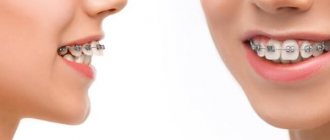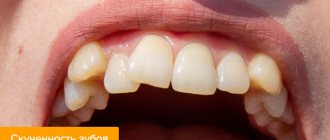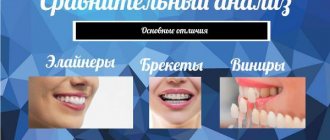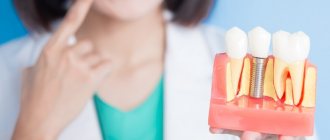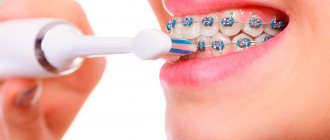The turn- key braces system effectively corrects the bite and straightens the dentition in adult patients of different ages. Certain contraindications to wearing fixed orthodontic structures, of course, exist. But in the vast majority of cases, mature people who decide to create an attractive open smile manage to achieve the planned result. You just need to prepare in advance for long-term treatment, during which you will have to adhere to strict discipline and strictly follow all the instructions of the attending physician. In this case, patients will be pleasantly surprised by the result.
What can you eat in the first days after getting braces?
Almost immediately after fixing the brace system in the oral cavity, the patient will experience unpleasant sensations associated with increased pressure on the dentition. Chewing may cause severe pain. Therefore, experts recommend in the first days to give preference to soft and strained food. The following products and dishes are optimal:
- liquid porridge;
- soups;
- cottage cheese;
- kefir;
- yoghurts;
- jelly;
- vegetable puree, etc.
What toothbrushes should you buy to care for braces?
For complete care, one v-shaped brush is not enough. In order to be sure that the teeth under the braces system are perfectly cleaned, you need to have several more types of brushes in your arsenal.
Interdental.
This type is used to clean spaces between brackets as well as areas under metal arches. Interdental brushes are available in different sizes, so they can also be used for deep cleaning of interdental spaces.
Mono-beam.
The mono-beam brush has a curved shape, thanks to which it can reach even the most difficult to reach places. This type of brush is intended for caring for braces, not teeth. Even the smallest clasps and ligatures will be perfectly clean with daily use of mono-tuft brushes.
It is worth knowing that any type of brush will wear out several times faster. This is due to the fact that when cleaning a metal system, the bristles can be pulled out. Therefore, you will have to change all care accessories much more often than recommended on the package.
What food is preferred throughout treatment?
When the patient gets used to the brace system, you can gradually expand the diet. The following is a list of products that will not cause any harm to the orthodontic structure:
- soups;
- yoghurts, kefir;
- soft cheeses;
- soft chicken fillet, thin sliced meat;
- fish, crab sticks;
- eggs;
- pasta;
- boiled rice;
- mashed potatoes;
- soft pastries, pancakes, bread crumbs;
- applesauce;
- bananas;
- jelly;
- milkshakes;
- vegetable caviar, stewed vegetables;
- cutlets, pureed meat.
The list of recommended products is quite large. It is important to understand that you should not bite hard food with your teeth. But if, for example, you grate an apple or carrot, you can eat them without fear for the safety of your braces.
Good to know. Braces are the best “nutritionist”. By adhering to some dietary restrictions, patients will receive not only straight and beautiful teeth, but also a slender figure.
If the braces are external, diction remains virtually unchanged
Commented by orthodontist, candidate of medical sciences Tatyana Gevorkyan
— Very often patients are puzzled by the issue of diction when wearing braces. And this doesn't only apply to adults. Almost all schoolchildren study a foreign language, and pronunciation is very important there.
This diction myth is wrong. External vestibular braces do not affect diction, since they are fixed on the outer surface of the teeth, while the tongue is located on the inside. Internal – lingual – braces “sin” with impaired diction (albeit temporarily). This is where you really need to get used to the innovations on your teeth for some time.
Can braces come off?
The system is securely, but not tightly, attached to a special glue, and when biting on some products, its elements may come off. This most often occurs when eating solid foods. If one or more braces come off, you need to consult a doctor.
You can install braces at the Saint-Dent Clinic in Moscow. Qualified dentists of all specializations work here. The clinic uses advanced technologies and modern materials to treat patients. The contact page is located here Contacts. Patients can find out the cost of dental services here Prices for dental services.
What products are prohibited?
Of course, after some time the diet can be expanded. However, some things are best avoided until the moment your braces are removed. For example, biting into very hard fruits or vegetables, crackers and nuts can break the metal wire that connects all the staples. When an archwire is damaged, the pressure exerted on the teeth immediately changes. As a result, treatment may be less effective or completely useless.
Dense and sticky foods can cause staples to peel off from the enamel. Of course, thanks to the use of dental glue, they are attached quite reliably, but it is better not to take risks. First of all, you should give up foods such as seeds, nuts, dried fruits, crackers, caramel, candies, apples, carrots, etc.
In addition, sticky products are also prohibited. This includes toffee, nougat, dried fruits, cheese and much more. They can stick to the surface of the braces and accumulate in hard-to-reach places under the archwire and brackets. Removing them even with a toothbrush and irrigator can be very problematic. It is recommended to limit the consumption of fresh bread, chewing gum and even corn flakes. Dentists advise you to temporarily stop eating coloring foods, for example, beets, candies with a high content of dyes, etc. Otherwise, the staples may become stained and lose their attractive appearance.
Hard and sticky food
Eating solid foods leads to damage to the arch structure and displacement of the dentition. This also often causes locks to come unstuck. The following products are completely prohibited:
- nuts;
- crackers;
- seeds;
- hard treats (lollipops, caramels);
- hard fruits and vegetables.
Sticky and viscous products heavily contaminate the teeth and components of the orthodontic apparatus and are quite difficult to remove. They also cause the development of caries and inflammatory processes in the gums. You should refuse:
- soft sticky candies;
- chips;
- buns
- corn sticks and flakes;
- cheese;
- chewing gum.
When can you see the results of treatment?
Statistics show that almost every fifth person on earth needs orthodontic dental treatment. These can be small defects, such as uneven teeth, and serious malocclusion, when it is not convenient to close molars or chew food, as well as the absence of some teeth.
As we have already said, the most effective tool for an orthodontist in correcting dental malocclusion is braces.
Gone are the days when such devices were made only of metal; nowadays you can choose lingual, sapphire or ceramic. Lingual braces are rightfully considered the most painless and aesthetic, however, due to their features, the period of wearing braces also increases.
When using the latest generation models, the patient will be able to see the first results of orthodontic therapy after just a few months, and it will take a year to achieve the final result.
Hot and cold food
Even people with absolutely healthy teeth should not expose their teeth to sudden temperature changes. And if a person wears braces, eating too hot and cold food is completely prohibited. This is especially true for bracket systems, which contain thermoactive elements that can change their properties under the influence of temperature.
You should avoid the following foods:
- cold ice cream and desserts;
- hot soup;
- scalding coffee, tea and other drinks.
Brief summary
How long you wear braces on your teeth depends on many factors. The summary table will help you navigate the average time frame, depending on the existing defect that requires correction:
| Deadlines | Defect requiring correction |
| 1-1.5 years | Correction of minor anomalies:
|
| From 2 years | For severe pathologies:
|
| Up to 3 years or more | Correction of the most serious and even rare defects, some of which require preliminary surgical intervention. |
Do not forget that after removing the braces, the treatment does not end, since from this moment the retention stage begins. Its duration can vary from 3-6 years, and in particularly difficult cases - throughout life.
Drinking alcohol and smoking during braces treatment
Drinking alcoholic beverages is undesirable, as they contain large amounts of sugar, which has a destructive effect on teeth. After drinking even a small amount of alcohol, a wearer of braces will have to brush their teeth. If this is not done, in the future you will have to deal with caries and inflammatory processes of the gums. In addition, alcohol leads to dry mouth. And this entails the occurrence of wounds and ulcers.
Smoking can spoil the appearance of the structure by staining some elements. It also leads to staining of tooth enamel, but in the places where braces are attached, the enamel will remain the same color. As a result, after removing the system, contrasting stains will be visible on the teeth. It is very difficult to even out the color, since nicotine is difficult to lighten. If you cannot completely quit smoking, you must at least reduce the number of cigarettes you smoke.
Why do braces cause irritation?
Modern metal and ceramic braces are small in size and have rounded edges. Although manufacturers try to make the design as comfortable as possible for patients, you need to get used to it, like any foreign body. But during the period of adaptation, irritation and inflammation may appear on the mucous membrane.
- The irritation may be an allergic reaction to the metal. In this case, treatment will most likely be suspended to replace the metal bracket system with a ceramic one. In order to avoid miscalculations, it is necessary to inform the orthodontist about your tendency to allergies even at the stage of choosing braces and, possibly, undergo additional examination at an allergy center.
- An orthodontic arch that is too long may be installed. By bending it, the dentist may not completely “twist” the sharp edge, which will scratch the mucous membrane and provoke the appearance of wounds.
- Quite often, the braces themselves, attached to the teeth, come off. The detached edge can also injure the mucous membrane, but on the inner surface of the lips.
All these problems can be solved with timely consultation with your doctor. The bracket will be glued, and the overly long edge of the arch will be trimmed and bent correctly. Rinsing with herbal decoctions will help quickly soothe irritated mucous membranes. A little more effort will be required if even after this the braces still rub the cheek mucosa.
Advice from professionals
- If the orthodontist has given the patient specific recommendations regarding what foods should absolutely not be consumed during treatment, they should be strictly followed.
- You can only chew soft foods with your front teeth. It is better to chew other foods with your back teeth.
- If the patient feels hungry and has tooth pain at the same time, it is worth drinking a cool smoothie or milkshake. The cold will ease the pain, and the drink will reduce the feeling of hunger.
- In the first days after installing the braces system, you should not touch your lower teeth to your upper teeth, as this can cause pain.
Pain while wearing
In the first few days after fixing the system, you may experience some tooth sensitivity and a range of unusually unpleasant sensations.
To remove them, it will be enough to take mild analgesics; ask your orthodontist about them in advance. Believe me, this discomfort normally disappears within 8-10 days from the moment the braces are installed.
Some places where the bracket system contacts the cheek may cause pain; friction may cause small wounds there, which will heal when lubricated with a special gel (you should also ask your doctor about this). Accidental impacts should be avoided, which will also injure the oral mucosa. If this happens, don't panic. It is best to rinse your mouth with warm salt water many times throughout the day, and the wound will heal.
Possible breakdowns - does the wearing period increase?
Sometimes you may encounter structural elements breaking and peeling off. The reason for this is sudden and excessive loads occurring:
- there is a shortage of space in the dentition or pronounced crowding of molars at the very beginning of bite correction - even minor movements of the teeth can create tension;
- careless use of cleaning accessories for oral care;
- violation of the diet, consumption of hard foods, and, as a result, damage to the system.
Of course, in this case, you need to consult a doctor immediately, since only in a specialized clinic can the detached element be fixed.
Remember that the entire system works as a single whole, and therefore the breakdown of even one element can affect how long you wear braces, since the functioning of the entire device is disrupted.
How long do you wear braces?
As for the time of wearing braces, they cope with their task on average in one and a half to two years.
Of course, only a doctor can predict how long braces should be worn based on an assessment of the complexity of the malocclusion, the patient’s age, as well as the results of the study and photographs.
The length of time you wear braces depends on what system is used:
- the minimum period of wearing braces is provided by self-ligating metal devices - the wearing time ranges from one year to one and a half years;
- if the patient uses lingual or ligature aesthetic or metal braces, the wearing time will be from one and a half to two years;
- Lingual systems are required to be worn the longest - at least two years, but they are increasingly preferred as patients do not want to advertise their treatment.
As a rule, it takes so much time to align the dentition, normalize the bite, and form the correct closure of the molars.
In any case, after an examination by a doctor, an approximate time frame for how long you need to wear braces will be determined. Such time limits will be more realistic, but they will also be affected by the patient’s participation in treatment - compliance with recommendations.
The most important thing in ensuring the stability of treatment results is a quality result. That is, the more thoroughly the alignment of the dentition is done and the better the bite, the more stability can be expected. Therefore, a good orthodontist will try to bring the results of therapy to the best possible. And if the doctor explains that you should still wear the orthodontic system, since there is no sufficient effect, and you can’t wait to remove it, then you should listen to the advice of a specialist.

